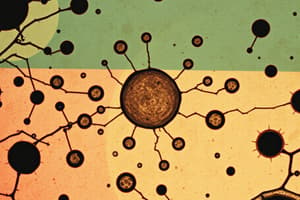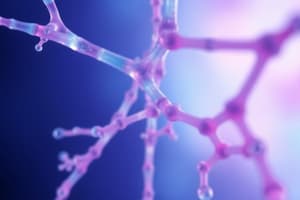Podcast
Questions and Answers
What is the primary function of a microscope?
What is the primary function of a microscope?
- To create living organisms in a lab setting
- To magnify light sources for better visibility
- To analyze chemical compositions of substances
- To observe objects that are too small for the naked eye (correct)
Which of the following statements is NOT a part of cell theory?
Which of the following statements is NOT a part of cell theory?
- All cells come from preexisting cells.
- All living things are made of one or more cells.
- Cells are the basic unit of structure and organization in living things.
- Cells can arise from abiotic materials. (correct)
Which scientist is credited with discovering animal cells?
Which scientist is credited with discovering animal cells?
- Anton van Leeuwenhoek (correct)
- Rudolf Virchow
- Matthias Schleiden
- Robert Hooke
What is a common laboratory safety protocol when using a microscope?
What is a common laboratory safety protocol when using a microscope?
What is one characteristic of living things?
What is one characteristic of living things?
How did the development of microscopes impact the study of living things?
How did the development of microscopes impact the study of living things?
Which of the following represents all living things?
Which of the following represents all living things?
What historical outcome might have occurred without the invention of microscopy?
What historical outcome might have occurred without the invention of microscopy?
What are the three main ideas encompassed by the Cell Theory?
What are the three main ideas encompassed by the Cell Theory?
How did Anton van Leeuwenhoek contribute to the study of cells?
How did Anton van Leeuwenhoek contribute to the study of cells?
What safety protocol must a student follow when using a microscope?
What safety protocol must a student follow when using a microscope?
Which part of a microscope should not be looked directly into, and why?
Which part of a microscope should not be looked directly into, and why?
What role does the microscope play in cellular biology?
What role does the microscope play in cellular biology?
How do living things differ from nonliving things based on their cellular composition?
How do living things differ from nonliving things based on their cellular composition?
What key functions do cells perform that characterize living organisms?
What key functions do cells perform that characterize living organisms?
In what way did the discovery of 'animalcules' change scientific understanding during Leeuwenhoek's time?
In what way did the discovery of 'animalcules' change scientific understanding during Leeuwenhoek's time?
Flashcards
Cell
Cell
The basic building block of all living things.
Cell Theory
Cell Theory
A set of three main ideas related to cells and living things.
Anton van Leeuwenhoek
Anton van Leeuwenhoek
A scientist who contributed to the understanding of cells.
Basic building blocks of life
Basic building blocks of life
Signup and view all the flashcards
Living things
Living things
Signup and view all the flashcards
Microscope
Microscope
Signup and view all the flashcards
Cell Theory components
Cell Theory components
Signup and view all the flashcards
Impact of early microscopes
Impact of early microscopes
Signup and view all the flashcards
What makes up all living things?
What makes up all living things?
Signup and view all the flashcards
How do we see cells?
How do we see cells?
Signup and view all the flashcards
Who discovered 'animalcules'?
Who discovered 'animalcules'?
Signup and view all the flashcards
What did Robert Hooke discover?
What did Robert Hooke discover?
Signup and view all the flashcards
What is cell theory?
What is cell theory?
Signup and view all the flashcards
What are the characteristics of living things?
What are the characteristics of living things?
Signup and view all the flashcards
Why is cell theory important?
Why is cell theory important?
Signup and view all the flashcards
How did the lack of microscopes impact society?
How did the lack of microscopes impact society?
Signup and view all the flashcards
Study Notes
Grade 7 Science
- Unit: 2, Chapter: 4 – Cells and Organisms, Lesson 1: Cells: The Basic Unit of Life
- Date: November 24, 2024
- Teacher: Ms. Joselyn M. Saclolo
Classroom Rules
- Be honest and responsible
- Use kind words
- Listen and follow directions
- Raise hand to speak
- Treat others with respect
- Keep work area clean
- Work hard and play safely
- Be brave and try new things
- Learn from mistakes
- Make thoughtful decisions
- Do your best
- Believe in yourself
Lesson Objective
- Students will study the development of the microscope.
- Understand its parts and functions
- Learn how microscopes advanced scientific discovery.
Laboratory Safety
- Always wear safety goggles and lab coats.
- Handle all glass slides and microscopes carefully to prevent breakage.
- Do not look directly into the microscope light source.
- Clean up spills immediately and report any accidents to the teacher.
- Follow school safety protocols at all times.
Compound Microscope Parts
- Eye piece
- Course adjustment knob
- Fine adjustment knob
- Body tube
- Inclination joint
- Revolving nose piece
- Objective
- Condenser
- Mirror
- Base
Timeline of Microscopy
- 1285: Glasses invented
- 1590: Modern Microscope born
- 1609: Galileo perfects the microscope
- 1625: Robert Hooke discovers cells
- 1665: Frits Zernike wins Nobel for Phase Contrast Method
- 1670: Anthony Van Leeuwenhoek perfects the microscope, Giovanni Faber coins the word "microscope"
- 1800: Richard Zsigmondy wins Nobel for Ultra Microscope
- 1926: Max Knoll and Ernst Ruska invent the electron microscope
- 1931: Antony van Leeuwenhoek perfects microscope
- 1953:
- 1986: Tunneling microscope
Vocabulary
- Cell: Basic building block of all living things
Starter Activity Questions
- What tools did people use to observe objects?
- Who invented the microscope?
- How did the lack of microscope technology hundreds of years ago affect society?
Living Things and Nonliving Things
- Living things reproduce
- Living things grow and develop
- Living things use energy
- Living things are organized
- Living things respond to stimuli
- Living things are made of one or more cells
Cell Theory
- Cell theory is a set of three main ideas related to cells and living things
- All living things are made of one or more cells
- Cells are the basic unit of structure and organization in living things
- All cells come from preexisting cells
Scientists and Their Contributions
- Zacharias Jensen (1595): Creates the first compound microscope
- Robert Hooke (1665): Views cells in cork, coin term "cell"
- Antonie van Leeuwenhoek (1670): Observe living cells in pond water
- Robert Brown (1833): Discovers the nucleus in plant cells
- Matthias Jakob Schleiden (1838): Proposes that all plant tissues are composed of cells
- Theodor Schwann (1839): Concludes that animal tissues are made of cells
- Carl Heinrich Braun (1845): Restates that cells are the basic unit of life
- Rudolf Virchow (1855): Adds that all cells come from preexisting cells
Assessment: Classwork Activity
-
Instructions: Match Column A with Column B, writing the letter of the correct answer for questions 1-5.
-
Column A: Anton van Leeuwenhoek, Cell, Cell Theory, Theodor Schwann, Matthias Schleiden
-
Column B: A. Discovered plants are made of cells, B. Discovered animals are made of cells, C. A set of three main ideas about cells and living things, D. Basic building block of living things, E. Uses microscopes with pond water
Studying That Suits You
Use AI to generate personalized quizzes and flashcards to suit your learning preferences.




